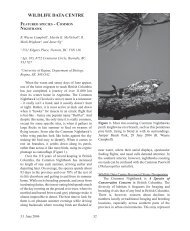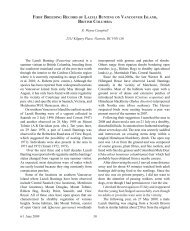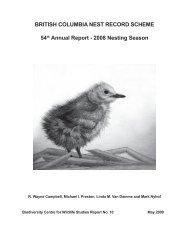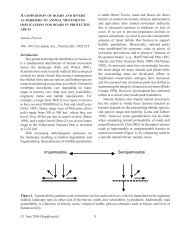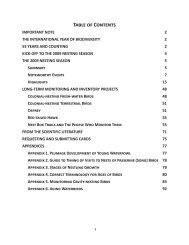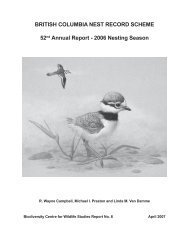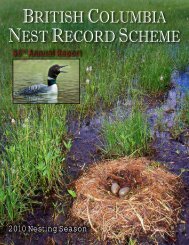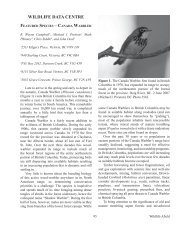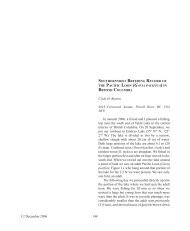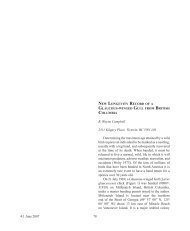American Bittern Eggs in American Coot Nests in British Columbia
American Bittern Eggs in American Coot Nests in British Columbia
American Bittern Eggs in American Coot Nests in British Columbia
Create successful ePaper yourself
Turn your PDF publications into a flip-book with our unique Google optimized e-Paper software.
Wildlife Afield 8(1):123-125, 2011<br />
© Biodiversity Centre for Wildlife Studies<br />
<strong>American</strong> <strong>Bittern</strong> <strong>Eggs</strong> <strong>in</strong> <strong>American</strong> <strong>Coot</strong> <strong>Nests</strong> <strong>in</strong> <strong>British</strong> <strong>Columbia</strong><br />
R. Wayne Campbell<br />
2511 Kilgary Place, Victoria, <strong>British</strong> <strong>Columbia</strong>, Canada V8N 1J6<br />
Brood parasitism by marsh-nest<strong>in</strong>g birds <strong>in</strong><br />
North America, which <strong>in</strong>volves waterfowl, coots,<br />
rails, and gall<strong>in</strong>ules, is fairly well known (e.g., Weller<br />
1959, Joyner 1976, Bellrose 1980, Arnold 1987, Lyon<br />
1993, Brisb<strong>in</strong> and Mowbray 2002). This reproductive<br />
strategy may be <strong>in</strong>terspecific, which <strong>in</strong>volves lay<strong>in</strong>g<br />
eggs <strong>in</strong> nests of other species, or conspecific, where<br />
eggs are laid <strong>in</strong> other nests of the same species. Far<br />
less is known about the occurrence and frequency of<br />
parasitism for other overwater nest<strong>in</strong>g species such<br />
as grebes, bitterns, and terns.<br />
In summer 2011, I found two <strong>in</strong>stances of<br />
<strong>in</strong>terspecific parasitism of <strong>American</strong> <strong>Coot</strong> (Fulica<br />
americana) nests by <strong>American</strong> <strong>Bittern</strong> (Botaurus<br />
lentig<strong>in</strong>osus) <strong>in</strong> south-central <strong>British</strong> <strong>Columbia</strong>. On<br />
12 June, an <strong>American</strong> <strong>Coot</strong> nest was found <strong>in</strong> a dense<br />
stand of bulrushes (Scirpus spp.) <strong>in</strong>terspersed with<br />
cattails (Typha latifolia) <strong>in</strong> Phillips Lake. This site is<br />
located about n<strong>in</strong>e kilometres south of the east end of<br />
Shuswap Lake. The coot nest conta<strong>in</strong>ed four <strong>in</strong>tact<br />
eggs plus eggshells from a hatched chick as well as<br />
two <strong>American</strong> <strong>Bittern</strong> eggs (Figure 1). The rema<strong>in</strong><strong>in</strong>g<br />
Figure 1. <strong>American</strong> <strong>Coot</strong> nest with two <strong>American</strong> <strong>Bittern</strong> eggs (top and centre) at Phillips Lake, BC. Photo<br />
by R. Wayne Campbell, 12 June 2010. BC Photo 3740 (see Campbell and Stirl<strong>in</strong>g 1971).<br />
123<br />
Wildlife Afield
coot eggs were ready to hatch, whereas the <strong>in</strong>cubation<br />
stage of the bittern eggs, tested by water floatation (see<br />
Campbell et al. 2001), were quite fresh, suggest<strong>in</strong>g<br />
the eggs had been laid dur<strong>in</strong>g the past few days. The<br />
coot nest was built mostly of cattails, about 23 cm (9<br />
<strong>in</strong>) high and 28 cm (11 <strong>in</strong>) across, and rimmed with a<br />
few stems of dead bulrushes (Figure 1).<br />
The second coot nest was located on 14 June<br />
<strong>in</strong> a large, bulrush marsh <strong>in</strong> Chapperon Lake on the<br />
Douglas Lake Ranch. It conta<strong>in</strong>ed two coot eggs and a<br />
one of a bittern (Figure 2). The nest was built entirely<br />
of dead bulrush stems, about 25 cm high and 33 cm <strong>in</strong><br />
diameter. The nest appeared abandoned as the three<br />
eggs were cold and no adults of either species were<br />
heard or seen <strong>in</strong> the immediate vic<strong>in</strong>ity of the nest. A<br />
family of coots, however, with four young about four<br />
days old were swimm<strong>in</strong>g along the lakeshore about 30<br />
m away. The coot eggs floated high suggest<strong>in</strong>g they<br />
were addled, whereas the bittern egg sank <strong>in</strong>dicat<strong>in</strong>g<br />
that <strong>in</strong>cubation had not yet begun.<br />
Nest<strong>in</strong>g habitat for wetland birds is affected by<br />
the amount of runoff from snowpack on surround<strong>in</strong>g<br />
mounta<strong>in</strong>s and the amount of ra<strong>in</strong>fall dur<strong>in</strong>g spr<strong>in</strong>g<br />
and early summer. These conditions alter water levels<br />
and restrict available habitat for nest sites (Fletcher<br />
and Koford 2004). The record-break<strong>in</strong>g weather<br />
<strong>in</strong> <strong>British</strong> <strong>Columbia</strong> <strong>in</strong> 2011 may have contributed<br />
to egg-dump<strong>in</strong>g by <strong>American</strong> <strong>Bittern</strong>s. While<br />
temperatures for the prov<strong>in</strong>ce were at least 3.5 o C<br />
lower than normal, and the prolonged cool and wet<br />
weather dur<strong>in</strong>g the spr<strong>in</strong>g and summer delayed the<br />
nest<strong>in</strong>g season for some species by up to three weeks,<br />
it was the unusually high water levels that impacted<br />
wetland- nest<strong>in</strong>g birds (see Campbell et al. <strong>in</strong> press).<br />
Water levels at Phillips and Chapperon lakes were at<br />
least 48-61 cm above normal levels and many nests of<br />
overwater nest<strong>in</strong>g species were flooded (pers. obs.).<br />
Many <strong>American</strong> <strong>Coot</strong> nests, however, that were not<br />
well anchored to emergent vegetation, floated with<br />
ris<strong>in</strong>g water.<br />
Figure 2. <strong>American</strong> <strong>Coot</strong> nest with a s<strong>in</strong>gle <strong>American</strong> <strong>Bittern</strong> egg (top) at Chapperon Lake, BC. Photo by R.<br />
Wayne Campbell, 14 June 2011. BC Photo 3741.<br />
8:1 June 2011 124
In <strong>British</strong> <strong>Columbia</strong>, 61% of <strong>American</strong> <strong>Bittern</strong><br />
nests with eggs (n = 28) were reported dur<strong>in</strong>g the<br />
last half of May and first half of June (Campbell et<br />
al. 1990). In 2011, water levels may have prevented<br />
suitable emergent plant cover and nest attachment for<br />
bitterns as the upper parts of reeds and cattails did not<br />
provide support, cover, or protection. Consequently,<br />
the species’ nest<strong>in</strong>g season may have progressed too<br />
far <strong>in</strong>to an abnormal year to resume normal nest<strong>in</strong>g<br />
activities.<br />
Redhead (Aythya americana) has been reported<br />
deposit<strong>in</strong>g eggs <strong>in</strong> an <strong>American</strong> <strong>Bittern</strong> nest <strong>in</strong> Iowa<br />
(Low 1940) and Alberta (Sealy 1965) but the records<br />
documented here for <strong>British</strong> <strong>Columbia</strong> are the first of<br />
<strong>American</strong> <strong>Bittern</strong> lay<strong>in</strong>g <strong>in</strong> nests of <strong>American</strong> <strong>Coot</strong><br />
or any other species (Gibbs et al. 1992). Of <strong>in</strong>terest<br />
is the recent report by Peer (2006) who found two<br />
<strong>in</strong>stances of <strong>American</strong> <strong>Coot</strong> parasitiz<strong>in</strong>g nests of<br />
Least <strong>Bittern</strong> (Ixobrychus exilis) <strong>in</strong> Iowa.<br />
As nest surveys for waterbirds are cont<strong>in</strong>ued and<br />
reported, <strong>in</strong>terspecific brood parasitism by <strong>American</strong><br />
<strong>Bittern</strong> may be found not to be as rare an event as<br />
first thought, especially dur<strong>in</strong>g periods of abnormal<br />
weather.<br />
Acknowledgements<br />
I thank Joe Gardner, manager of Douglas Lake<br />
Ranch, for permission to access Chapperon Lake<br />
through private land. Spencer G. Sealy reviewed<br />
this note.<br />
Literature Cited<br />
Arnold, T.W. 1987. Conspecific egg<br />
discrim<strong>in</strong>ation <strong>in</strong> <strong>American</strong> <strong>Coot</strong>s. Condor 89:675-<br />
676.<br />
Bellrose, F.C. 1980. Ducks, geese & swans<br />
of North America. Stackpole Books, Harrisburgh,<br />
PA. 540 pp.<br />
Brisb<strong>in</strong>, I.L. and T.B. Mowbray. 2002.<br />
<strong>American</strong> <strong>Coot</strong> (Fulica americana) and Hawaiian<br />
<strong>Coot</strong> (Fulica alai). In The birds of North America, No.<br />
697 (A. Poole and F. Gill, eds.). The Birds of North<br />
America, Inc., Philadelphia, PA. 44 pp.<br />
Campbell, R.W. and M.I. Preston. 2001. <strong>British</strong><br />
<strong>Columbia</strong> nest record scheme 46 th annual report – 2000<br />
nest<strong>in</strong>g season. Wild Bird Trust of <strong>British</strong> <strong>Columbia</strong><br />
Wildlife Report No. 7, Victoria, BC. 26 pp.<br />
Campbell, R.W. and D. Stirl<strong>in</strong>g. 1971. A<br />
photoduplicate file for <strong>British</strong> <strong>Columbia</strong> vertebrate<br />
records. Syesis 4(1/2):217-222.<br />
Campbell, R.W., L.M. Van Damme, M. Nyhof,<br />
and P. Huet. In press. <strong>British</strong> <strong>Columbia</strong> nest records<br />
scheme 56 th annual report – 2011 nest<strong>in</strong>g season.<br />
Biodiversity Centre for Wildlife Studies Report No.<br />
16, Victoria, BC.<br />
Fletcher, R.J. and R.R. Koford. 2004.<br />
Consequence of ra<strong>in</strong>fall variation for breed<strong>in</strong>g<br />
wetland blackbirds. Canadian Journal of Zoology<br />
82:1316-1325.<br />
Gibbs, J.P., S. Melv<strong>in</strong>, and F.A. Reid. 1992.<br />
<strong>American</strong> <strong>Bittern</strong>. In The birds of North America,<br />
No. 18 (A. Poole, P. Stettenheim, and F. Gill, eds.).<br />
The Academy of Natural Sciences; Wash<strong>in</strong>gton, DC.<br />
The <strong>American</strong> Ornithologists’ Union. 12 pp.<br />
Low, J.B. 1940. Production of the Redhead<br />
(Nyroca americana) <strong>in</strong> Iowa. Wilson Bullet<strong>in</strong> 52:153-<br />
164.<br />
Lyon, B.E. 1993. The ecology and evolution<br />
of conspecific brood parasitism <strong>in</strong> <strong>American</strong> <strong>Coot</strong>s<br />
(Fulica americana). Animal Behaviour 46:911-928.<br />
Peer, B.D. 2006. <strong>American</strong> <strong>Coot</strong> parasitism<br />
on Least <strong>Bittern</strong>s. Wilson Journal of Ornithology<br />
118:415-418.<br />
Sealy, S.G. 1965. Redhead parasitiz<strong>in</strong>g the nest<br />
of the <strong>American</strong> <strong>Bittern</strong>. Blue Jay 23:172-173.<br />
Weller, M.W. 1959. Parasitic egg lay<strong>in</strong>g <strong>in</strong><br />
the Redhead (Aythya americana) and other North<br />
<strong>American</strong> Anatidae. Ecological Monographs 29:333-<br />
365.<br />
125<br />
Wildlife Afield



